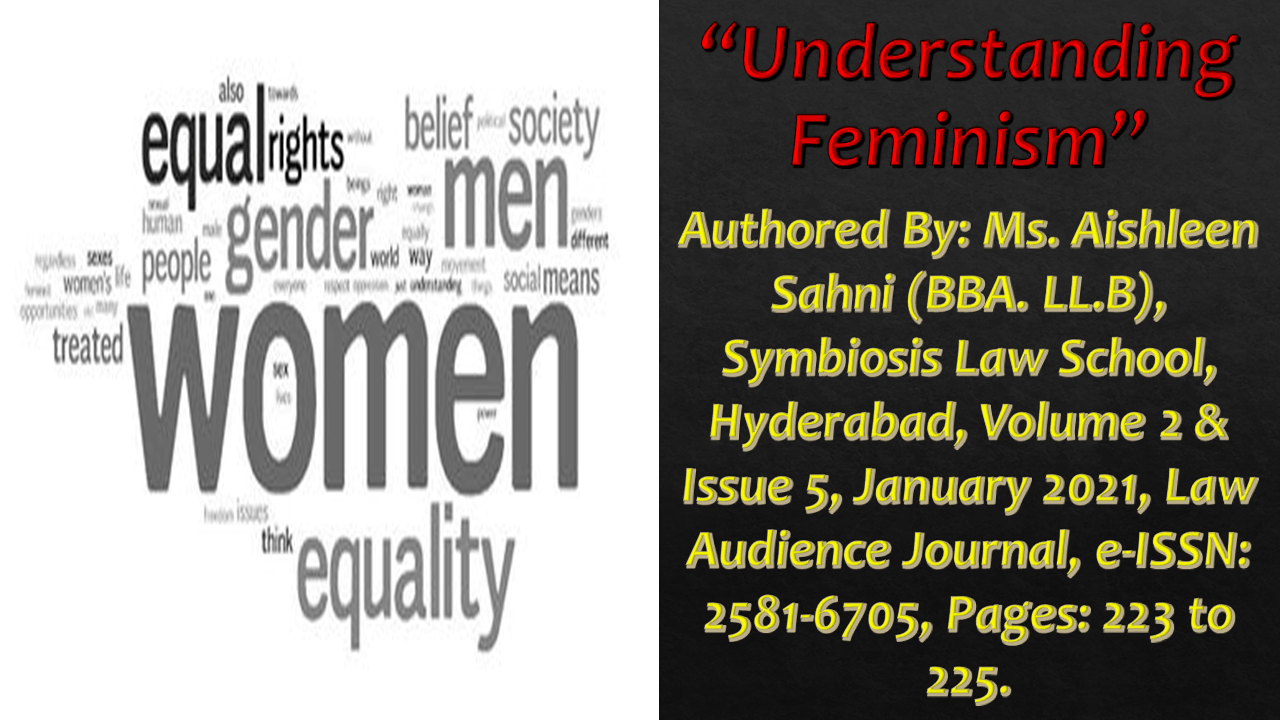Click here to download the full paper (PDF)
Authored By: Ms. Aishleen Sahni (BBA. LL.B), Symbiosis Law School, Hyderabad,
Click here for Copyright Policy.
Click here for Disclaimer.
“Understanding Feminism”
Feminism is defined in the Oxford English Dictionary as “equality between the sexes”. Feminism in its most pure form is striving towards; equal rights, opportunities and representation amongst all genders irrespective of their sexual orientation. It began as a social outcry in the year 1848 at the Seneca Falls Convention, when people gathered together to demand equal rights and opportunities for women.
It has however, since then turned into a political movement along with its social branches for instance; feminist movements like pink chaddi movement, #MeToo, slut walk to name a few. These movements have highlighted the injustice and unfair treatment that is meted out to women. They are also embedded with feminism and its ideologies; and are used to sway the political approach of the parties towards a more ‘female-empowering’ view.
What is surprising though is how negatively feminism is often perceived in the society. The whole concept of feminism is surrounded by a dense fog of myths, misconceptions and fallacy. But let us approach these erroneous beliefs in steps, understand where they come from and how much truth do they actually hold. The first and foremost area where feminism is often misunderstood lies in its very name. The term starts with “fem” which automatically creates a bias in the mind of an individual that the concept is probably inclusive only for females. Some hardliners and biased thinkers take this a step further and assume that since the movement is pro-female it must be anti-male. Critics have even argued that if feminism is about equality between the sexes, why is it so female oriented; right from its name?
For instance- if there are two scales that are unequal, to make them equal you can either take away the weights from a scale or add more weight to the other scale. Now take these weights as rights and the scales as men and women respectively. To bring both the sexes at the same level of rights and opportunities, one can either take the already excising rights away from the men or give women the same rights, the latter obviously being the more logical choice. This is the reason that the concept of feminism is so pro-women and even indicates that through the name. This also goes on to disprove the gross myth that all feminists hate men.
Feminism is synonymous to equality in some ways and is also inclusive of the plights faced by men in forms of gender stereotyping, toxic masculinity etc. The myth that all feminists hate men has turned into such a strong belief that it has even coined a new term for these so-called men hating ‘feminists’ i.e., “feminazi”. A feminazi is basically someone who has radical views about the principles of feminism but that is just a glorified explanation; a feminazi is just a sexist. They have extreme “anti-men” views and believe that all men are against women empowerment and are misogynists. This is an extreme and false notion which has its basis in sexism and therefore is the complete opposite of feminism as sexism and equality-the leading principle of feminism-have nothing to do with each other. To call a feminazi a “feminist with radical views” is simply wrong and downright disrespectful to the ideals of feminism.
Touching upon another myth that has its roots wedged in the above explained misconception is that feminists want to undermine men and aim to be more powerful than them. Again, a view this radical and this ‘anti-men’ is everything that feminism is fighting against. Moreover this would beat the very purpose of the whole movement as if one gender strives to rise above and oppress the other gender; it again creates the same cycle of oppression and discrimination-only in reverse. A fallacy about feminism that is exclusive to India and a few other Asian countries is that feminism is just a western concept which is not really applicable in their country as it supposedly steers theirs women away from their duties, responsibilities, ideals and religion. This is an extremely orthodox view of feminism and has somewhere in it a hidden motive of keeping the women of these countries oppressed and unaware of their rights. This is less of a misconception about feminism and more of a way to make sure that the systematic oppression continues.
The myths and fallacy about feminism grow as steadily as they disproved. With each new movement that tries to bring us closer towards equality and women empowerment, a new line of attack is created. This even happened in the #MeToo movement which brought with it the new term of “Fake Feminism” or “Pseudo Feminism”.
The #MeToo opened our eyes to the extent to which sexual violence is prevalent or rather ever growing in our society. It brought with it stories of women from all around the world who dared to speak up about the abuse they had faced or were facing. But it also opened our eyes to the wave of fake feminism existing all around us. Men and women claiming to be feminist turned against these victims claiming that their stories could have been false or fabricated. Instead of showing support and sympathy to the survivors and respecting the mental trauma they must be going through, they attacked these women for not reporting or waiting to report or simply speaking up. Some even went as far as to say that the whole #MeToo movement was propaganda against men so as to make it easier to have them blamed for sexual misconduct. This is where fake feminism showed its true colours. Becoming a bad spot on the ideals of feminism, fake feminism gave rise to many misconceptions about the whole feminist movement and painted the real feminist all around the world in bad picture.
For this reason, it is important that from a very young age people in our society are made exposed to gender balanced way of life. The way our society functions is extremely problematic in terms of its understanding of gender, stereotyping, socialization and all rationalising the believes that one gender is superior than the other. This belief needs to change if we need to have a fair and just society. We need strong plan for transforming our education system, societal norms, code of conduct which need to be rebooted in order for them to be gender neutral and should also have the scope for continuous evolvement.
Changes like these will not happen overnight, this is a belief system that the society has been following since ages. However, it’s important to acknowledge that we as a society still have a long way ahead of us for making it a gender neutral and balanced society for the coming generations.



